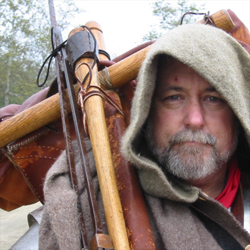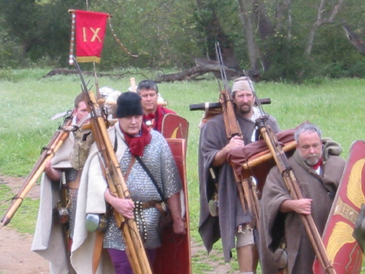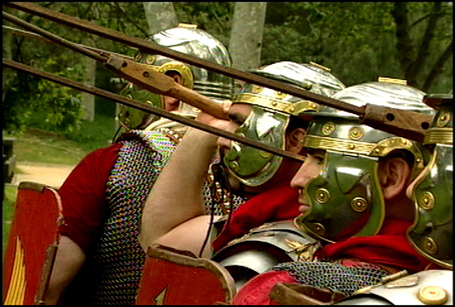Becoming a Roman Reenactor
By G V. Tacitus Hibernicus (a.k.a. Sean Richards)
Not all Roman Reenactment Clubs are the Same. It is important for you to
know what you want from Roman reenactment and what Roman reenactment has to offer.
Knowing what you want will help you make an informed decision about the level of Roman reenactment you want
to participate at. Knowing what Roman reenactment has to offer will help you decide which club to join.
Roman Reenactment Clubs are the Same. It is important for you to
know what you want from Roman reenactment and what Roman reenactment has to offer.
Knowing what you want will help you make an informed decision about the level of Roman reenactment you want
to participate at. Knowing what Roman reenactment has to offer will help you decide which club to join.
Shop Around
That's why you are strongly encouraged to explore membership in nearby clubs. Explore their webpages, contact their leadership, accept an invitation to attend a workshop or event. Some clubs have broad themes, others have detailed personas while others might be timelines of Roman history and social status. Find out if they are the right club for you. A nearby club may have what you want to achieve as a Roman reenactor.
There are many Roman reenactment clubs across North America. Some have been around for several years others for a few months. There is no national or international governing body. Each club is unique; each has a different philosophy of Roman reenactment; each has a different mandated level of historic accuracy for weapons, armor and other necessary equipment.
Here are a couple of equipment examples:
- Some clubs allow a commercially available lorica segmentata while other groups prohibit them;
- Some clubs allow shields made of modern plywood instead of built of laminated strips — it's all what you want to be part of.
It is important to understand why these differences exist within the Roman reenactment community because they might play an important role in how you approach Roman reenactment or the club you choose to join.
 A Way of Life vs. Just a Hobby
A Way of Life vs. Just a Hobby
For some participants, Roman reenactment is simply a hobby, a casual and occasional pasttime activity; some use reenactment as a means to collect armor, weapons and equipment from one or more Roman eras; some participants are content with having enough basic gear to passably portray a Roman soldier from their favorite era; for others its a deep abiding passion. You will likely find that most clubs have a mix of members who participate at various levels.
A Commitment
Roman reenactment has a multi-year commitment. The average guy, based on our 15+ years of experience, takes about a year to acquire the Basic Soldier Kit (armor, weapons, clothes, footgear, shield) and if he makes most of it himself it will cost $700 - $800. There are about 200 hours of labor, more if you need to learn new skills. The typical participant takes about 3 years to complete his Full Soldier Kit!
"Experimental Archeology "
Roman military archeology is incomplete. There is not enough archaeological and historical evidence to create a complete Roman soldier from any Roman era. For example: it is as basic as not knowing with certainty what color a 1st C AD soldier's tunica was. Within the Roman reenactment community there are debates about this and many other aspects of reenactment and the reproduction of equipment. In order to answer the questions that the debates pose many clubs have adopted a set of Rules or Standards for themselves that may conflict with another club's Standards. Often aspects from one era are used to fill gaps in another because the record for any one era is often woefully incomplete.
Time Requirements
Then there's the time required for training in order to learn the skills of a Roman soldier. Basic Skills: parade drills; commands; proper and safe weapons handling. Intermediate Skills: campaign marches; pitching a tent; fire starting; food preparation; basic gladius skills. Advanced Skills: engineering; artillery use; mutli-day treks; combined weapons attack and defense techniques; massed pila volleys. What do you have time for? What do you have the physical strength and stamina for?
Caveat Emptor!
You should also be aware that here are pitfalls when looking to buy gear from online vendors. Too many vendors list gear, often unknowingly, as reenactor quality when it's not. This is why it is essential that you have a complete understanding of the vendors or equipment that a club approves. Because different clubs often have different standards, one club may list a vendor as approved; another may only list one or two items from that vendor as meeting it's standards; another may not have an approved vendor's list but instead has detailed specifications and enjoins members to buy only gear that meets those specifications.
 Travel?
Travel?
Can you travel? What is a reasonable distance for you to travel? National and regional gatherings of Roman clubs are often many hours (or days!) away either by ground or air. How are you and your gear going to get there?
A Family Affair?
Is your family going to participate? Some clubs strongly encourage family participation. Others are "bachelor clubs".
In Closing
As you can see there are many things to consider when choosing a Roman reenactment club to join: a club's proximity to you; historical era portrayed; it's overall theme as a specific military unit in a specific place and time or as a general timeline of history and social status levels; the standards for historic accuracy in reconstructed gear and accouterments; time and money; your level of involvement; your goals as a Roman reenactor. There are many excellent clubs across North America. Take the time to explore your options and learn about Roman reenactment before deciding which club to join.











